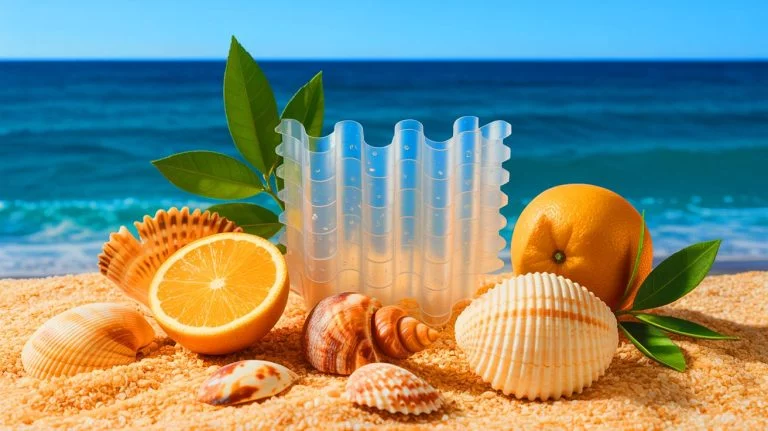| IN A NUTSHELL |
|
As the world grapples with the overwhelming challenge of plastic pollution in our oceans, a team of researchers at the University of Southern California (USC) is offering a glimmer of hope. Led by Eun Ji Chung, the team has developed a biodegradable, ocean-safe plastic alternative that promises to significantly reduce the impact of plastic waste on marine ecosystems. Drawing on her background in biomaterials, Chung and her colleagues have engineered a material using seashell minerals and citric acid polymers, potentially setting a new benchmark in sustainable materials science.
The Urgent Need for Ocean-Safe Plastics
Plastic pollution is a dire environmental concern that continues to endanger marine life across the globe. According to UNESCO, plastics make up 80 percent of all ocean pollution, with an estimated 8 to 10 million metric tons entering the oceans each year. This alarming statistic has galvanized researchers and environmentalists to seek viable alternatives to traditional plastics. The USC Viterbi School of Engineering team, led by Chung, has identified a promising solution in the form of a natural substance found in seashells.
The new material, which integrates calcium carbonate from seashells with a biodegradable polymer known as poly (1,8-octanediol-co-citrate) (POC), offers a sustainable alternative that is both robust and ocean-friendly. POC is already FDA-approved for certain medical applications, underscoring its safety and effectiveness. Chung’s team is hopeful that this innovation will reduce the reliance on traditional plastics and mitigate their harmful impact on the environment.
From Biomedical Polymers to Sustainable Solutions
Chung’s foray into sustainable plastics builds on her earlier work with biodegradable medical polymers. During her graduate studies, she explored the use of polymers derived from citric acid, a compound found in citrus fruits, for medical applications such as sutures and tendon repair devices. Chung’s innovative approach involved adding calcium particles, similar to those found in bones, to enhance the material’s properties.
Building on this foundation, Chung hypothesized that the calcium carbonate in seashells could serve a similar purpose. This led to the development of the POC-CC material, a novel plastic alternative that is both biodegradable and suitable for industrial applications. The material’s sticky texture, akin to gum, becomes robust and plastic-like when heated and cured. This has enabled the creation of prototypes such as beverage holder rings, offering a tangible glimpse into the material’s potential uses.
Testing the Material’s Durability and Environmental Impact
To ensure the material’s viability, the research team conducted extensive tests to evaluate its durability and degradation in marine environments. By synthesizing POC-CC with varying concentrations of calcium carbonate, the team assessed factors such as weight degradation and the material’s impact on ocean water pH over six months. Their findings revealed that higher POC content accelerated degradation, while the addition of calcium carbonate maintained water pH levels.
One of the standout features of the POC-CC material is its biocompatibility. Unlike conventional plastics, which can harm marine life, POC-CC does not introduce harmful microplastics into the ecosystem. Tests involving green algae (Scenedesmus sp.) confirmed the material’s compatibility with marine microorganisms, showcasing its potential as a safe alternative. The team is already working on a second-generation version that promises even faster degradation, further enhancing its environmental credentials.
Future Applications and Implications
The potential applications for this groundbreaking material extend beyond beverage holders. Chung envisions its use in a variety of products, including biodegradable straws that offer a more sustainable alternative to bamboo, paper, and reusable metal straws. Such innovations could play a key role in reducing the environmental footprint of everyday consumer products.
This research, funded by the National Oceanic and Atmospheric Administration and the USC Sea Grant Program, represents a significant step forward in the quest for sustainable materials. By harnessing the properties of natural compounds, the USC team is paving the way for a new era of environmentally friendly plastics. As the research progresses, the implications for industries worldwide could be profound, offering a viable path to reducing plastic pollution.
As the quest for sustainable alternatives to traditional plastics continues, the work of Eun Ji Chung and her team offers a promising avenue for reducing ocean pollution. Their innovative approach not only addresses a critical environmental issue but also challenges industries to rethink their reliance on conventional materials. How might these advancements in biodegradable materials influence future regulations and industry practices on a global scale?
Did you like it? 4.5/5 (29)







Wow, this could be a game-changer for our oceans! 🌊
How long until we see this POC-CC material on the market?
Finally, a real solution to plastic pollution! Thank you, USC researchers! 🙌
Is the production of POC-CC scalable? Can it meet global demand?
Sounds promising, but what about the cost compared to traditional plastics?
Can POC-CC be used in food packaging? 🍔
Hope this isn’t just another overhyped “solution” that fades away.